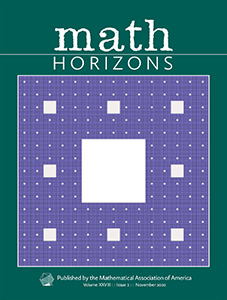
Bona's Bonus Problems are special mathematical challenges for students of St. Bonaventure. A Bona's Bonus Problem is any problem posed in the problem section of a recent issue of a mathematics journal such as Math Horizons, The Pi Mu Epsilon Journal, Crux Mathematicorum, Mathematics Magazine, The College Mathematics Journal, or The American Mathematical Monthly.
If a student solves any Bona's Bonus Problem in accordance with the Rules below, the student may bring his or her solution to Dr. Chris Hill to receive the following benefits:
- the student's name will subsequently appear in the journal as a solver of the problem and the student's solution MAY be chosen to be PUBLISHED in the journal;
- the Mathematics Department will give the student one (1) free tee-shirt with a groovy mathematical design and a copy of the journal's issue in which his or her name appears;
- the student will be immortalized in the BBP Hall of Fame (the list of students who successfully solved one or more Bona's Bonus Problems).
For more information about Bona's Bonus Problems, including lists of problems posed in recent issues of mathematics journals, please contact Dr. Chris Hill.
Students interested in mathematical problem solving are encouraged to take MATH 281, The Problem-Solving Seminar. In the Seminar, problem-solving strategies are studied and applied to a wide range of problems. As the same techniques are applied to problems in calculus, discrete mathematics, geometry, and other areas, mathematics is revealed as a unified discipline rather than a collection of unrelated topics.
The Seminar emphasizes the value of attempts and partial solutions—when a problem-solving technique does not seem to work on a particular problem, progress has been made on the problem and insight has been gained into the technique.
During previous Problem-Solving Seminars, students solved problems posed in the problems sections of national undergraduate journals such as Math Horizons, The College Mathematics Journal, and the Pi Mu Epsilon Journal.
MATH 281 is a one-credit course offered during the fall semester. The prerequisites are MATH 152 (Calculus II) and MATH 207 (Discrete Mathematics I).